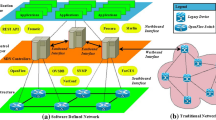Abstract
Recent years have witnessed an explosive growth in multimedia streaming applications over the Internet. Notably, Content Delivery Networks (CDN) and Peer-to-Peer (P2P) networks have emerged as two effective paradigms for delivering multimedia contents over the Internet. One salient feature shared between these two networks is the inherent support for path diversity streaming where a receiver receives multiple streams simultaneously on different network paths as a result of having multiple senders. In this paper, we propose a network coding framework for efficient video streaming in CDNs and P2P networks in which, multiple servers/peers are employed to simultaneously stream a video to a single receiver. We show that network coding techniques can (a) eliminate the need for tight synchronization between the senders, (b) be integrated easily with TCP, and (c) reduce server’s storage in CDN settings. Importantly, we propose the Hierarchical Network Coding (HNC) technique to be used with scalable video bit stream to combat bandwidth fluctuation on the Internet. Simulations demonstrate that under certain scenarios, our proposed network coding techniques can result in bandwidth saving up to 60% over the traditional schemes.









Similar content being viewed by others
Notes
As compared to using a single server to send the pieces to multiple receivers.
References
Tan, W., & Zakhor, A. (1999). Real-time internet video using error resilient scalable compression and tcp-friendly transport protocol. IEEE Transactions on Multimedia, 1, 172–186, June.
Ma, H., & El Zarki, M. (1998). Broadcast/multicast mpeg-2 video over wireless channels using header redundancy fec strategies. In Proceedings of the international society for optical engineering (SPIE) (Vol. 3528, pp. 69–80), November.
Rejaie, R., & Ortega, A. (2003). Pals:peer to peer adaptive layered streaming. In NOSSDAV, June.
Nguyen, T., & Zakhor, A. (2002). Distributed video streaming. In Proceedings of the SPIE - The international society for optical engineering, multimedia computing and networking (MMCN) (Vol. 4673, pp. 186–95). San Jose, CA, January.
Apostolopoulos, J. (2002). On multiple description streaming with content delivery networks. In InfoComm (Vol. 4310), June
Andersen, D. G. H., Balakrishnan, M. F., Kaashoek, & Morris, R. (2001). The case for resilient overlay networks. In Proceeding of HotOS VIII, May
Nguyen, T., & Zakhor, A. (2004). Multiple sender distributed video streaming. IEEE Transactions on Multimedia, 6(2), 315–326. April.
Rejaie, R., & Stafford, S. (2004). A framework for architecting peer-2-peer receiver-driven overlays. in NOSSDAV, June.
Zhang, X. J. C., Liu, B., Li, & Yum, T. P. (2005). Coolstreaming/donet: A data-driven overlay network for efficient live media streaming. In INFOCOM, March.
Tran, D. A., Hua, K. A., & Do, T. (2003). Zigzag: An efficient peer-2-peer scheme for media streaming. In INFO COM, April.
Ahlswede, R. Cai, N., Li, R., & Yeung, R. W. (2000). Network information flow. IEEE Transactions on Information Theory, 46, 1204–1216, July.
Koetter, R., & Medard, M. (2003). An algebraic approach to network coding. IEEE/ACM Transactions Networking, 11(5), 782–795, Oct.
Ho, T. R., Koetter, M., Médard, M., Effors, M., Shi, J., & Karger, D. (2006). A random linear network coding approach to multicast. IEEE/ACM Transtions on Information Theory, 52(10), 4413–4430, Oct.
Ho, T. Koetter, R., Médard, M., Karger, D. R., & Effros, M. (2003). Benefits of coding over routing in a randomized setting. In IEEE international symposium on information theory
Nguyen, K., Nguyen, T., & Cheung, S. (2007). Peer-to-peer streaming with hierarchical network coding. In IEEE international conference on multmedia and expo, 2007, July .
Information Sciences Institute (2009). Network simulator. http://www.isi.edu/nsnam/ns.
Byers, J., Considine, J., Mitzenmacher, M., & Rost, S. (2004). Informed content delivery across adaptive overlay networks. IEEE/ACM Transactions on Networking, 12(5), 767–780, Oct.
Gkantsidis, C., & Rodriguez, P. (2005). Network coding for large scale content distribution. In IEEE Infocom, March
Acendanski, S., Deb, S., Medard, M., & Koetter, R. (2005). How good is random linear coding based distributed networked storage? In NetCod.
Padmanabhan, V. N., Wang, H. J., Chou, P. A., & Sripanidkulchai, K. (2002). Distributed streaming media content using cooperative networking. In ACM NOSSDAV, Miami, FL, May
Li, J., Chou, P., & Zhang, C. (2005). Mutualcast: An efficient mechanism for one-to-many content distribution. In ACM Sigcomm Asia Workshop, April.
Author information
Authors and Affiliations
Corresponding author
Additional information
This work is supported under the NSF grant: CNS 0834775; CNS 0845476.
Rights and permissions
About this article
Cite this article
Nguyen, K., Nguyen, T. & Cheung, SC. Video Streaming with Network Coding. J Sign Process Syst Sign Image Video Technol 59, 319–333 (2010). https://doi.org/10.1007/s11265-009-0342-7
Received:
Revised:
Accepted:
Published:
Issue Date:
DOI: https://doi.org/10.1007/s11265-009-0342-7




